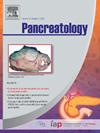Pancreatitis pain quality changes at year 1 follow-up, but GP130 remains a biomarker for pain
IF 2.7
2区 医学
Q2 GASTROENTEROLOGY & HEPATOLOGY
引用次数: 0
Abstract
Background/objectives
Debilitating abdominal pain is a common symptom affecting patients with chronic pancreatitis (CP). CP pain is dynamic due to multiple underlying mechanisms. The objective of this study was to 1) evaluate changes in pain phenotype at one year follow-up and 2) validate putative pain biomarkers in a prospective cohort study.
Methods
The Neuropathic and Nociceptive PROMIS-PQ questionnaires were used to classify pain for participants with in the PROCEED study. Putative serum biomarkers were measured via immunoassay.
Results
At enrollment, 17.6 % (120/681) subjects with CP reported no pain in the previous year. Of those, 29 % experienced pain during the 1 yr follow-up whereas 18 % of those with pain prior to enrollment reported no pain during the 1 yr follow-up period. Of the 393 subjects with PROMIS-PQ data at enrollment, 212 also had follow-up data at 1 yr. Approximately half (53.3 %) of those individuals changed pain phenotype between baseline and follow-up. At 1 yr, serum TGFβ1 level was negatively correlated with nociceptive T-scores (p = 0.006). GP130 was significantly correlated with both nociceptive (p = 0.012) and neuropathic T-scores (p = 0.043) at 1 yr, which is consistent with the previously published findings.
Conclusions
The positive association between TGFβ1 and pain is not maintained over time, suggesting it is a poor pain biomarker. However, serum GP130 is a consistent biomarker for mixed-type pain in CP. Preclinical studies show that targeting TGFβ1 or IL-6 (ligand for GP130) is sufficient to inhibit CP pain supporting further investigation of this as a potential therapeutic target.
胰腺炎疼痛质量在第一年随访时发生了变化,但 GP130 仍是疼痛的生物标志物。
背景/目的:使人衰弱的腹痛是慢性胰腺炎(CP)患者的常见症状。由于多种潜在机制的影响,慢性胰腺炎疼痛是动态的。本研究的目的是:1)评估随访一年后疼痛表型的变化;2)在前瞻性队列研究中验证推测的疼痛生物标志物:方法:使用神经病理性和痛觉性 PROMIS-PQ 问卷对 PROCEED 研究参与者的疼痛进行分类。通过免疫测定法测定血清中的假定生物标志物:在注册时,17.6%(120/681)的 CP 患者表示在过去一年中没有疼痛感。其中 29% 的受试者在随访 1 年期间出现过疼痛,而在入组前有疼痛的受试者中有 18% 在随访 1 年期间没有出现过疼痛。在入组时有 PROMIS-PQ 数据的 393 名受试者中,有 212 人也有 1 年的随访数据。其中约有一半(53.3%)的人在基线和随访期间改变了疼痛表型。1 年后,血清 TGFβ1 水平与痛觉 T 分数呈负相关(p = 0.006)。1 年后,GP130 与痛觉 T 评分(p = 0.012)和神经病理性 T 评分(p = 0.043)均有明显相关性,这与之前发表的研究结果一致:结论:TGFβ1与疼痛之间的正相关并不会随着时间的推移而持续,这表明它是一种不良的疼痛生物标志物。然而,血清 GP130 是 CP 混合型疼痛的一致生物标志物。临床前研究表明,以 TGFβ1 或 IL-6(GP130 的配体)为靶点足以抑制 CP 疼痛,支持将其作为潜在治疗靶点进行进一步研究。
本文章由计算机程序翻译,如有差异,请以英文原文为准。
求助全文
约1分钟内获得全文
求助全文
来源期刊

Pancreatology
医学-胃肠肝病学
CiteScore
7.20
自引率
5.60%
发文量
194
审稿时长
44 days
期刊介绍:
Pancreatology is the official journal of the International Association of Pancreatology (IAP), the European Pancreatic Club (EPC) and several national societies and study groups around the world. Dedicated to the understanding and treatment of exocrine as well as endocrine pancreatic disease, this multidisciplinary periodical publishes original basic, translational and clinical pancreatic research from a range of fields including gastroenterology, oncology, surgery, pharmacology, cellular and molecular biology as well as endocrinology, immunology and epidemiology. Readers can expect to gain new insights into pancreatic physiology and into the pathogenesis, diagnosis, therapeutic approaches and prognosis of pancreatic diseases. The journal features original articles, case reports, consensus guidelines and topical, cutting edge reviews, thus representing a source of valuable, novel information for clinical and basic researchers alike.
 求助内容:
求助内容: 应助结果提醒方式:
应助结果提醒方式:


